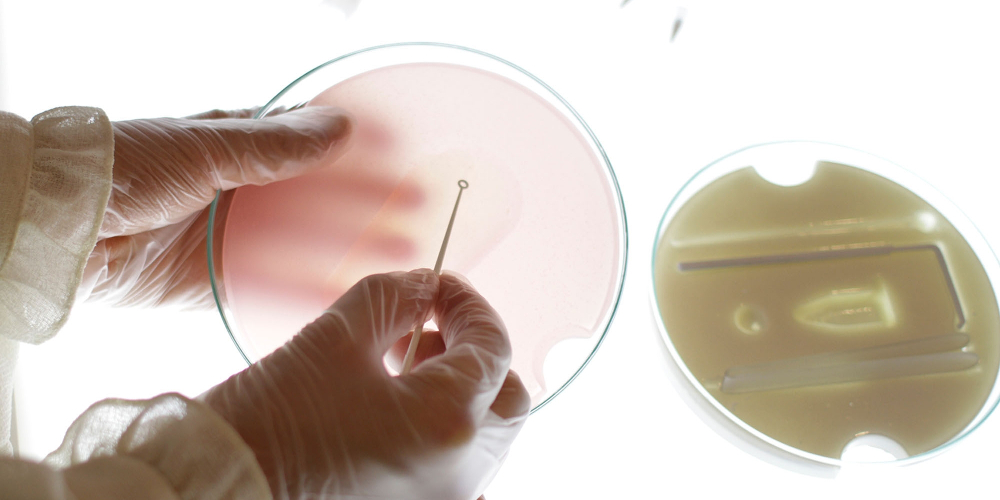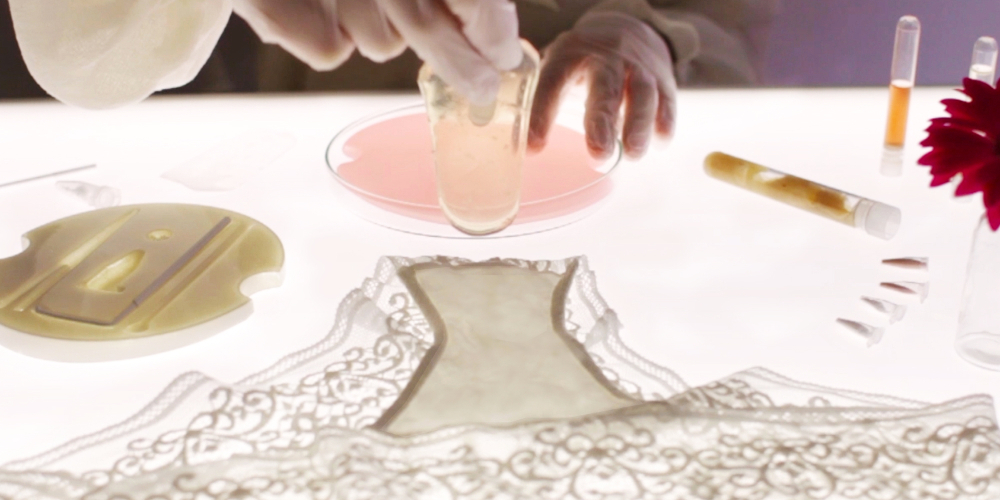Celebrating Female Biophilia
Grand Prize – Artistic Exploration: Awarded for artistic exploration and art works where appropriation by the arts has a strong potential to influence or alter the use, deployment or perception of technology.
We aren’t just single individuals walking the planet: we are walking ecosystems made of microbes.
Microbes are in the soil, in the water, and even in our bodies. The average human body is made up of trillions of cells: therefore, we can easily say that we are only 10% human. We live and co-exist with them. The other 90% of the human body is composed of different microorganisms, most of which are beneficial to their host. Microbes as bacteria, fungi, and viruses are part of our Skin Microflora, covering both the inside and the outer surface of the body. Even though invisible to our eyes, our microflora has a symbiotic relationship with the interface between our body and the environment—our skin.[1]
Future Flora aims to encourage this symbiotic relationship that raises the beneficial presence of microbes and bacteria in the human body, suggesting an alternative: to wear probiotics and keep our body healthy. Future Flora is a harvesting kit designed for women to treat and prevent vaginal infections. The user is a woman who wants to embrace biotechnology in her house, allowing science to show alternatives to traditional medicines and probiotics.
Following DIY procedures and merging biology with health-tech, Future Flora addresses women who are taking control of their own bodies as a precious and intimate practice of self-care, becoming a participant in the culture and the knowledge of science.
How can design challenge our perception and celebrate the symbiotic relationship between the human body and its microbiome? Aiming to encourage this symbiotic relationship that raises the beneficial presence of microbes and bacteria in the human body and suggesting an alternative of wearing probiotics in our underwear to keep the body healthy.

The project tackles the experience of growing and nurturing living organisms at home. The bacterial pad grows the necessary strings of Lactobacillus bacteria to create a hostile environment for the further development of Candida Albicans, acting as a living culture of probiotics. By placing the pad in contact with the female genitalia, the healthy bacteria grow on the surface of the infected area, reconstructing the microflora missing in the vagina epithelium. Considering that 75% of women suffer from Candidal vulvovaginitis (CVV) at least once in their lifetime, Future Flora explores women’s approach in the context of personal self-care and body awareness, generating an intimate and delicate interaction between the action of nurturing bacteria while they grow, and then wearing them as a second layer of your panties.
Celebrating a Female Biophilia, Tomasello opens the possibility of wearing microorganisms in the future, and embracing them as part of our natural well-being. Taking care of her own health, the woman becomes a citizen scientist, establishing a first relation with her body and what is part of her living surroundings. Clothes and accessories become the ecosystem that balance the entire skin microflora.

Future Flora proposes alternatives to embrace biological remedies in our home, challenging the values and beliefs that our society embodied in the material culture. The intention behind Future Flora is to design a tool that will educate and enable women to take a more active role in their healthcare, prompting them to seek medical advice as necessary and ultimately break some of the taboos associated with urogynecology health. Designed to empower women and increase their self-care, becoming familiar with their own bodies, developing self-confidence, and becoming active patients able to seek healthcare professional advice, discuss their symptoms openly and ultimately break the taboos that are still associated with gynecological health. A social stigma that is still pervasive in both developed and developing countries. Future Flora aims to encourage new propositions for the society and for the future of women’s healthcare by introducing the importance of a female biophilia’s approach.
[1] The Human Microbiome Project, a research initiative by the US National Institutes of Health (2008-2017), investigated the role of microbial flora in human health and disease. Info adapted from https://en.wikipedia.org/wiki/Human_Microbiome_Project
Credits
Giulia Tomasello (IT), born in 1990, is an interaction designer and researcher specializing in wearables, biotechnology, and material finishes. She is currently Research Assistant in Interactive Wearables at Nottingham Trent University. In the past two years she has been investigating the potential of biotechnology and living materials, proposing a biological and sustainable alternative for electronic textiles. She considers herself a maker and explorer, using materiality to question and communicate the boundaries between technology and our bodies. By designing alternative scenarios and acting as a creative thinker, Giulia questions our notions of wellbeing to develop innovative tools in the intersection of medical and social sciences. These intersections are enabled by her multidisciplinary collaborations and the symbiosis between her creative and scientific work, generating knowledge exchange and social integrations in healthcare.
Future Flora
Designer and creator: Giulia Tomasello
Graduate project from Material Futures Master Course
Central Saint Martins College of Art & Design
External expert: Biologist Arian Mirzarafie-Ahi
Future Flora (Video)
https://vimeo.com/171795174
Film, editing and art direction, designer: João Gil
Sound/Music: Anne Queffelec – Eric Satie, Gnossienne n4
Girl Biophilia (Documentary)
https://www.youtube.com/watch?v=DMYIOHzpu-E
Creative direction and production: Maja Zupano
Director of photography: Jan Vrhovnik
Production design: Maja Zupano
1st AC: Kash Khan
Production assistant: Max Celar
Lighting: Jan Vrhovnik
Styling: Martina Rocca
SOUND
Boom operator: Julia Hardecka
Music composer: Joseph Daly
Sound design: Julia Hardecka
Location and talent scout: Maja Zupano
POST PRODUCTION
Film editing: Maja Zupano
Color grading: Jan Vrhovnik
CAST THE GIRLS
Vanessa David
Sharondeep Kaur Johal
Kristina Lipinskaite
Martina Rocca
FUTURE FLORA
Designer and creator: Giulia Tomasello
SCIENTIST
Science communicator, founder at The A Level Biologist: Arian Mirzarafie-Ah
Jury Statement
Through the thick digital forest, there was a distinctive and loud call for returning to nature, attention to life, biology, the self, the body—especially empowering the female body and its sexuality which came as no surprise after a year of #MeToo. Responding to this collective consciousness wave, the jury agreed that Future Flora embraced the issues of reclaiming female power—with DIY and no shame—in a way that could prove empowering to others seeking to find a voice. Interaction designer Giulia Tomasello brings to the forefront issues that the medical community should consider in their production of pharmaceuticals for women. This project also engages the public to consider feminine hygiene and the surrounding taboos. It makes us think differently about bacteria in general—important in times of overuse of antibiotics and antiseptics that are destroying the ecological balance. With the advent of scientific research into the microbiome, the designer asks how we feel about the idea that we consist almost entirely of bacteria. Many existing thrush treatments include a whole host of chemicals that cure yeast infections but also destroy good bacteria, making things worse for women. In her own words, Giulia explains that “the kit has been designed to allow women to establish, nurture and harvest their very own personal skin flora at home, becoming not only consumers but also active participants in their own health and wellbeing.” Digital technologies are tricking us into an immaterial world made out of shining data. As Digital Ghosts, we are hallucinating about being almighty, even immortal under the sun of a God-like AI. Giulia Tomasello forces us to lower our gaze from the digital heaven to the most vulnerable female body part—the vagina. With Future Flora she demonstrates this vulnerability as a strength, using the embodied openness as a medium between internal and external organisms, creating in this way what she calls ‘Future Flora’. Future Flora provides a clear and loud signal that ‘Future’ is not only ‘Digital’. The S+T+ARTS Prize Jury got Giulia’s eye-opening message: there is a huge potential for innovation in the European spirit, but we must not forget that it is our bodily existence that fuels the imagination.



